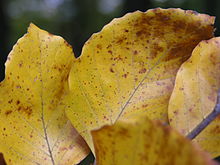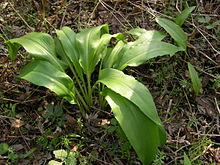Leaf vein
This article has been registered in the quality assurance biology for improvement due to formal or content-related deficiencies . This is done in order to bring the quality of the biology articles to an acceptable level. Please help improve this article! Articles that are not significantly improved can be deleted if necessary.
Read the more detailed information in the minimum requirements for biology articles .


Leaf veins , also called leaf veins or in their entirety called nerves , are the vascular bundles in the leaf blades of the leaves . They serve the influx of water and nutrients, the removal of assimilates (in living beings by conversion of exogenous substances into the body's own substances), as well as mechanical reinforcement.
A distinction is made between the stronger main veins (also main nerves) and the more delicate vascular bundles (side nerves). There are basically four types of nerve:
- One-nerved (uninervate): with a central vein without secondary veins, for example in the horsetail (Equisetum) or the fork-leaf family (Psilotaceae)
- Parallel veined: predominantly in the Liliopsida ( monocot ). The main vascular bundles run lengthways and parallel to each other, which creates the mostly smooth leaf margin of the monocot. They are linked by weaker transverse bundles that are sometimes noticeable to the naked eye. The stomata are also mostly aligned in parallel.
-
Netznervatur (reticulate) (closed Vein): typical of dicots . The complicated arrangement of the vascular bundle nets makes almost any shape of the leaf blade and the leaf margin possible. The stomata are also arranged irregularly. There are now three types:
- pinnate: with secondary veins along a central median vein.
- threefold (ternate): with 3 main arteries from the basal point.
- palmate: with 4 or more primary veins from the basal point.
There are two more special forms:
- (penni-parallel): With essentially parallel, secondary veins extending from the midrib to the edges.
- (palmati-parallel): If there are several primary veins from a single point, with parallel secondary veins.
The tertiary veins can be continuous, step-shaped (percurrente, scalariforme) or reticulate (reticulate), as well as at right angles to the main vein (perpendicular).
- Fork or fan veins (dichotomous): is found mainly in Polypodiophyta ( fern plants ) and the ginkgo belonging to the Pinophyta ( naked plants ) . The vascular bundles are dichotomously ( fork-shaped ) branched and end blindly at the front edge of the leaf (open nerve).
The nervous system can also be classified according to another, complicated system; after Hickey and Wolfe , 1975.
In classical botany, leaf veins are a characteristic for determining the relationship. However, this feature is only of limited significance, with some taxa the relationships can be determined very well using the leaf veins, with other taxa this does not work. In paleobotany , the leaf veins are used to compare fossilized leaves with the leaves of today's species and to determine the relationship.
Hydrangea with hand-shaped network nerves
Detailed view of a taro leaf with recognizable leaf veins
Underside of the leaf of a battes of the tulip tree ( Liriodendron tulipifera )
literature
- Andreas Bresinsky, Christian Körner, Joachim W. Kadereit, Gunther Neuhaus, Uwe Sonnewald: Strasburger - textbook of botany. 36th edition. Spectrum Akademischer Verlag, Heidelberg 2008, ISBN 978-3-8274-1455-7 .
Individual evidence
- ^ Leo J. Hickey and Jack A. Wolfe: The bases of angiosperm phylogeny: vegetative morphology. In: Annals of the Missouri Botanical Garden. 62 (3), 1975, pp. 538-589, quoted in: Leaf Architecture Working Group: Manual of Leaf Architecture. Smithsonian Institution, 1999, ISBN 0-9677554-0-9 , online (PDF; 4.06 MB), at geosc.psu.edu, accessed June 15, 2017.




